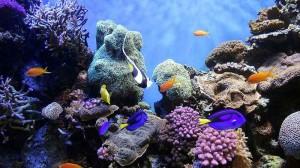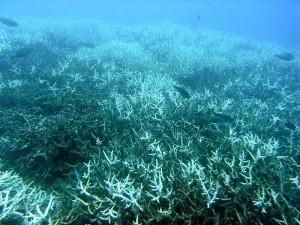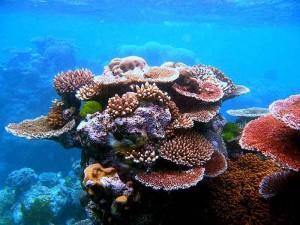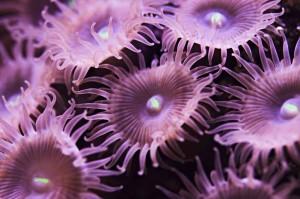


Reefs are vital
Coral reefs provide food to millions of people, unique chemicals for use in medicine, protect coastlines from erosion and storms, and are a major part of the thriving global tourism industry. In all, it is estimated that coral reefs contribute $375 billion to the world economy.
In addition to coral reefs’ numerous economic benefits, they also contain an astounding amount of biodiversity. Although coral reefs occupy only a small fraction of the world’s oceans, they provide a home to 25% of all marine species.
Understanding Reefs
Almost all corals are colonial organisms composed of hundreds or thousands of individual coral polyps clustered together in groups. Most reefs are built from stony corals, with each tiny anenome-like polyp surrounded by a calcium carbonate shell. The unique and vibrant colors of many stony corals come from their zooxanthellae partners.

Releasing zooxanthellae is a natural way for the coral to lower photosynthetic production when needed.
But environmental changes in temperate, light, nutrients and water temperature can overly stress corals and cause them to release too many zooxanthellae and turn completely white – causing coral bleaching, Bleaching causes the coral a great deal of stress and greatly increases the chance of death.

Ocean acidification has also been shown to cause coral bleaching.
Recent reports on the speed and severity of ocean acidification have alarmed the scientific community. Ocean acidification is now considered as problematic as global climate change, and the projected impact on coral reefs is dire. Most of the world’s coral reefs will be devastated if current levels of carbon dioxide emissions are allowed persist and continue to contribute to ocean acidification.
If nothing is done, over 90% of the earth’s coral reefs will be threatened by 2030.
Below is an educational video on how coral reefs function.
Three Ways You Can Help Coral Reefs Survive:
1. Inform yourself about the seafood you eat.
Some seafood is more sustainable than others. For example, wild Alaskan Salmon has less of a negative impacton the environment than farm-grown Salmon.
2. Choose ecologically responsible and sustainable tourism.
Spending your money with travel companies that believe in ecotourism and benefit the local community can go a long way toward protecting the environment.
3. Lower your carbon footprint.
Reducing your daily commute, consumption, and travel can help to reduce pollution, climate change, acidification of the oceans, and coral bleaching.
Read more:
World Resources Institute – Reefs at Risk
Coral Triangle Reefs Threatened At Rate Above Global Average, Report Finds
Photos courtesy of Fascinating Universe, J. Roff, Toby Hudson via Wikimedia Commons, and Arnar Valdimarsson